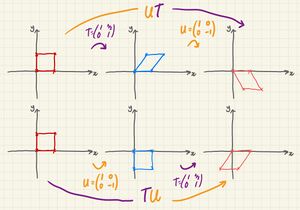A linear transformation moves points from an xy-grid onto new locations on the xy-grid, according to a transformation matrix M.
We know certain basic types of transformation that are relatively easy to understand and work with. For example: enlargement, reflection, rotation, shear.
We can combine these to build a composite transformation by applying a sequence of these basic transformations.
Prerequisites
We'll assume you already know about:
Order Matters!

First of all, it's important to note that the order of a sequence of transformations matters - like matrix multiplication, it is NOT commutative. If you change the order of transformations, you will typically get different results.
If we do a shear followed by a reflection, that will give different results than a reflection followed by a shear.
Sequence of two transformations
Suppose we have two transformation matrices and , and a point with coordinates , which we'll represent in position vector form: .
We want to apply the two transformation matrices one-by-one: first A, then B.
To apply transformation A, we need to pre-multiply by the matrix A, so .
To then apply a second transformation matrix , this also has to be pre-multiplied. will go in first place: .
Note that matrix multiplication is not commutative - so we cannot swap the order of and . must come before .
However, matrix multiplication is associative - we can process the multiplications in two different orders:
- first calculate and then pre-multiply by B, giving , or,
- first calculate and then pre-multiply by , also giving .
Two Transformations in One
The transformation followed by the transformation can be represented by the transformation (note the order!).
We could now think about this as the single composite transformation .
Interpreting Composite Transformations: Order Matters
When we have a composite transformation, such as , we may want to think about it also as a sequence. The transformation closest to the position vector always happens first in the sequence.
When we apply the composite transformation, we have to pre-multiply by , giving: .
Thinking about the decomposed transformations and , we see is closest to the position vector, so we know transformation happens first. Then, transformation happens second.
Next Steps
- Lines of Invariant Points, Invariant Lines
- Types of Linear Transformation
- Combinations of Linear Transformations
- Area and Volume in Linear Transformations
Footnotes